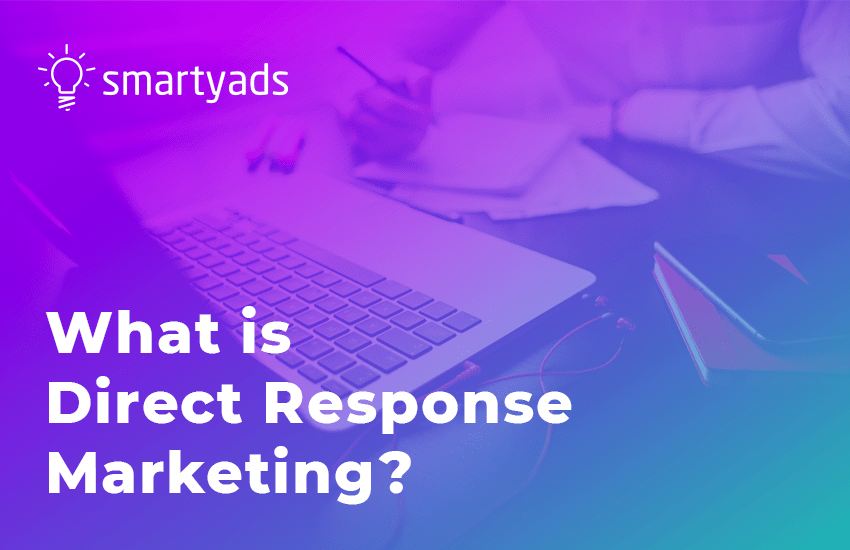Direct response marketing is a type of sales technique designed to evoke an on-the-spot response and encourage a prospective customer to take immediate action by opting for the advertiser's offer.
Unlike traditional marketing, which focuses on building brand awareness and generating interest in a product or service over time, direct response marketing seeks to drive immediate response from the customer.
This type of marketing is often associated with direct mail campaigns, infomercials, telemarketing, and email marketing.
Compelling offers and calls-to-action drives direct response marketing to encourage customers to take action.
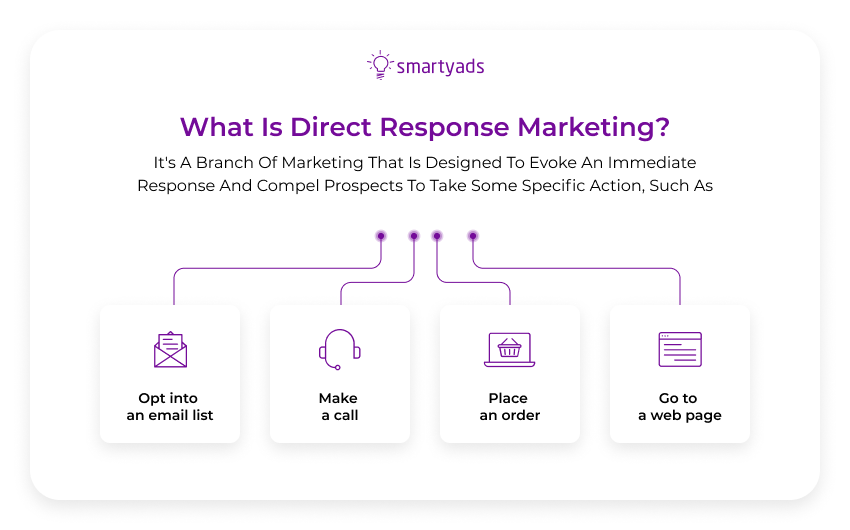
It also requires careful tracking and measurement of results, so marketers can determine which tactics are working and which need to be adjusted.
Direct response marketing works with nearly all forms of advertising, including TV commercials, print marketing (magazines, newspapers, etc.), radio spots, websites, and online ads.
Advertisers push prospects through all marketing channels and generate leads quickly by creating an irresistible offer. Lead generation is a process of converting strangers and passers-by into paying customers.
The desired response massively depends on the goals of a specific ad. For instance, in exchange for the free offer, the advertiser may ask a prospect to sign up, share contacts, register on a website, etc.
Compared to traditional advertising, which focuses on raising brand awareness and promoting a brand image, direct response campaigns immediately expect a return on investment.
With brand advertisement, it may take months or even years until consumers start recognizing the company's logo and start making purchases, whereas direct marketing is all about instant deals.
Why is Direct Response Marketing important?
Direct response marketing is a very useful tool for marketers. It can play a significant r>ole in developing a brand's digital marketing and strategy.
Let's look at the reasons why you should definitely pay attention to direct response marketing:
You can get Measurable Results
Direct response marketing allows marketers to track and measure the results of their ad campaigns. This means they can see exactly how many people responded to their offers, which offers were the most effective, and which tactics need to be adjusted for better results.
It's Cost-effective
Direct response marketing can be cost-effective because it is highly targeted and focused on driving specific actions.
This means that small businesses can avoid wasting money on advertising to people unlikely to be interested in their product or service.
It increases Customer Engagement
Direct response marketing is designed to engage customers and encourage them to respond immediately.
By providing compelling offers and calls-to-action in direct response ads, businesses can build a relationship with customers and increase their likelihood of making a purchase.
It gives you Flexibility
Direct response marketing allows businesses to be flexible in their approach. They can adjust their offers and tactics based on their results and test different approaches to see what works best.
It Encourages users to Immediate Response
Direct response marketing is focused on generating an immediate, direct response to advertisements. This means that businesses can see results quickly and make adjustments to their campaigns in real time.
What are the key components of direct response marketing campaigns?
Advertising that supports a direct response marketing strategy is intended to sell products immediately. Hence the ad and the buying decision are consecutive. Direct response ad must trigger instant feedback; otherwise, it fails. A typical direct response ad necessarily includes the following elements:
An offer
An "offer" is a combination of factors such as the product itself, the cost per unit, trial period, terms, optional features, guarantee, incentives, future obligations, time or quantity limit, shipping, handling, etc.
Very often, the aim of the offer is not to sell anything but rather to get the prospect's interest and lead them to the next action, such as requesting a free demo version of the product. Usually, the offer is fixed on a prospect and appeals to their emotions, desires, frustrations, and fears.
Information
Direct response ads must have enough information for customer consideration and immediate acceptance of the offer. As a rule, the less famous the product is, the more information is needed.
On average, the advertiser has 4 seconds to grab the recipient's attention. Thus, the message must be personalized, relevant, and persuasive.
Advertisers provide reasons to accept the offer and highlight the value of the offering, including information about why this product is better than others available.
Call-to-action and means of response

Each direct response ad contains a clear CTA, forcing the visitor to do something specific and moving them further down the sales funnel. A few common examples of direct response:
- Use this coupon at the counter;
- Follow the link below;
- Contact us immediately by calling this number;
- Subscribe to our monthly newsletter;
- Share an image/article/ad with your friends;
- Download a free trial/beta version of the product;
- Sign up for a mailing list;
- Buy now and receive a discount, etc.
Typically, advertisers include multiple options for response, such as toll-free numbers, emails, websites, etc. Marketers often use expiration dates and deadlines to create a sense of urgency and hurry their audience to act as quickly as possible, almost impulsively.
Direct Response Marketing channels
Different channels are needed to increase the reach of your target audience. You can simultaneously use one or more channels for a successful direct-response marketing campaign. Here are some of the most common ones:
Direct mail
Direct mail is a form of direct response marketing that involves sending physical mail, such as postcards, letters, or catalogs, to a targeted list of potential customers. Direct mail can be an effective way to reach a specific audience and generate a response.
One of the benefits of direct mail is that it can be highly personalized, allowing businesses to tailor their message to their audience's specific interests and needs.
Direct mail can also be used with other channels, such as email, social media ads, or referral programs to create a more integrated and effective ad campaign.
Email marketing
This channel allows you to send promotional messages or offers directly to a targeted list of email subscribers.
Email marketing campaigns typically involve creating a targeted email list based on demographics, geographic location, or past purchase behavior.
One of the benefits of this channel is that it allows businesses to reach their audience in a relatively low-cost way. It can also be highly personalized, allowing businesses to tailor their message and offers to their subscribers' specific interests and needs.
Social media advertising
Social media ad is a form of direct response marketing — the well-known creation of targeted ads on platforms such as Facebook, Twitter, or LinkedIn.
However, it's important to note that social media ads can be a competitive space, and it's important to create compelling content and offers that stand out from the competition.
Monitoring and optimizing ad performance, such as adjusting targeting or ad creative, is also important to maximize effectiveness and return on investment.
Pay-per-click advertising
This channel allows you to create targeted ads that appear at the top of search engine results or other websites.
In a PPC campaign, advertisers create ads that are displayed on search engine results or websites that are part of a network of sites that display ads.
The advertiser selects specific keywords or topics related to their product or service and then sets a bid for how much they are willing to pay each time someone clicks on their ad. The higher the bid, the more likely the ad will be displayed to users.
Telemarketing
Telemarketing is telephone calls to a targeted list of potential customers to promote a product or service.
Telemarketing can be an effective way to generate immediate responses from potential customers, especially when combined with other direct response marketing tactics such as email or direct mail.
However, it can also be controversial and subject to regulation, especially when it involves unsolicited calls or the use of automated dialing systems. It is important for companies to follow best practices and comply with relevant regulations to avoid potential legal issues and maintain a positive reputation.
Infomercials
Infomercials involve long television commercials that provide detailed information about a product or service and contain a CTA to order.
In direct response marketing, infomercials are often used to generate sales and leads by providing a compelling demonstration of the product or service being offered.
Infomercials typically run for 30 minutes to an hour and include a combination of product demonstrations, testimonials, and sales pitches. They are often aired during late-night or early-morning hours when viewers are more likely to be receptive to the message.
But infomercials can also be expensive to produce and air, and there is no guarantee of success.
Print advertising
This channel includes ads in newspapers, magazines, or other print publications.
Print advertising can be a cost-effective way to attract leads and sales, especially when combined with other direct response marketing tactics such as email or telemarketing. But it's important to carefully target your audience and choose the right print media to ensure that the right people see the ads.
Event marketing
Event marketing is a form of direct response marketing in which companies host or participate in events, such as trade shows, conferences, or product demonstrations, to promote their products or services and generate leads or sales.
In an event marketing campaign, companies create a plan for how they will participate in or host events that their target audience is likely to attend. This may involve setting up a booth or exhibit, giving presentations or speeches, or sponsoring the event.
The key to the success of any of these channels is to determine which ones are most effective for your audience and to create compelling offers and calls -to action that prompt a response.
What are the benefits of direct response advertising?
Generating immediate ROI (return on investment). Direct response is all about instant reaction and immediate revenues from instant sales.
With programmatic advertising, media buyers can determine the price for one impression at a time and bid only on those impressions that bring value.
Trackable performance. When a user responds (clicks, signs up, etc.), the advertiser knows exactly which ad and which media generated that impression.
When buying through DSP (demand-side platform), advertisers can determine whether ads are effective, which target group is affected by the ad the most, what is the engagement rate, what amount of clicks is generated daily, and so on; all data is simply displayed on the dashboard.
Measurable outcomes. Since advertisers know precisely which ads are being responded to and how much revenue is coming from each one, they can easily evaluate the campaign performance.
For this reason, direct response is one possible way to test the scale of consumer responses with a small campaign before launching a full-volume campaign. In digital advertising, advertisers measure campaign outcomes via DSP's granular and real-time metrics.
Targeting specific audiences. While a branding campaign targets everybody in order to promote brand awareness, a successful direct response campaign is all about people who are most likely interested in the product.
When buying digital ad space through RTB (Real-time bidding), advertisers deliver relevant ads in front of the right person in the right context and at the right time.
Precise segmentation. Marketers can develop effective segmentation strategies by buying a list of potential consumers, such as new car buyers, credit card users, clothing shoppers, etc.
With programmatic advertising, advertisers can use ad networks specializing in the content types they cover, like entertainment, beauty, traveling, food, etc.
These websites would then be grouped into vertical channels and sold out to advertisers who wish to reach out to people interested in these topics.
Alternatively, some ad networks sell audience segments built on demographic, behavioral data, or user interests.
How to create a Direct Response Marketing campaign?
There are many different options for creating a successful direct-response marketing campaign. However, we'll discuss the basic steps necessary to launch such a campaign. Depending on your goals, you may add additional steps to these.
Identify your target audience
This is probably the common step for every digital marketing campaign. You need to know who you are targeting and who should be interested in your product or service.
Identify your ideal customer and profile their demographics, interests, and behaviors. This will help you tailor your marketing message to their specific needs and preferences.
Develop a compelling offer
To get a user interested in buying, you must offer them something worth their attention. Your offer should be what your target audience wants and needs. It must be relevant, valuable, and unique. Your offer could be a discount, a free trial, a bonus product, or a special package.
Make a strong CTA
A strong CTA does not have to be unique; the most important thing is that it clearly reflects the essence of your offer and what you want from the user.
Your CTA should be clear and specific. It should tell your audience exactly what you want them to do, whether to make a purchase, fill out a form, or call a phone number.
Choose the right marketing channel
Don't forget that many different tools are available to achieve your marketing goals, and you can choose which ones to use. Don't limit yourself to one channel, experiment and analyze which channels work best for your target audience.
Decide which channels will be most effective in reaching your target audience. It could be direct mail, email, social media, pay-per-click advertising, or a combination of these channels.
For example, a small business owner can build brand awareness and drive more sales in the store by launching an outdoor ad campaign with DOOH.
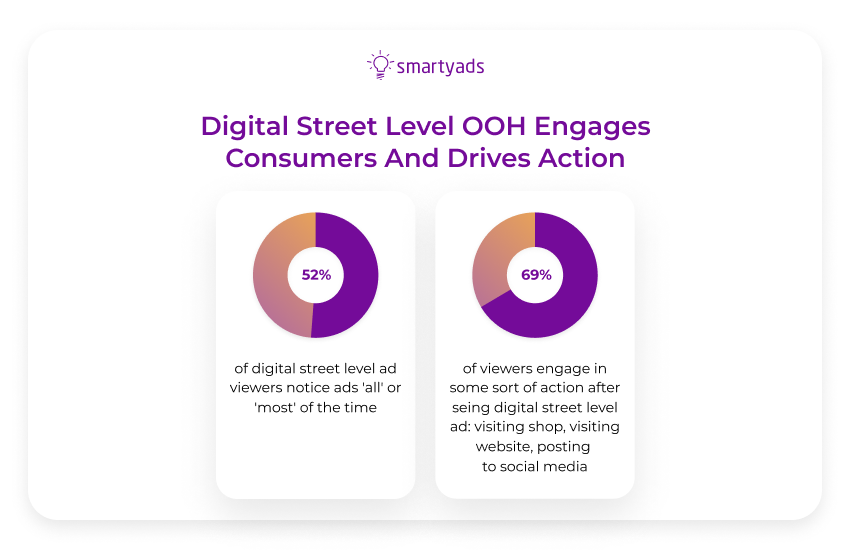
Programmatic DOOH is on the rise; thanks to it, brands launch effective direct-response campaigns based on data. These ads are reaching even people who have busy lives and don't use their gadgets frequently.
In order to promote brand image long term, small businesses can also use programmatic audio advertising, which can address people when they are busy.
Digital audio ad spend is projected to reach $8.594 million only in the US, all thanks to the growing popularity caused by increased podcast and digital radio consumption.
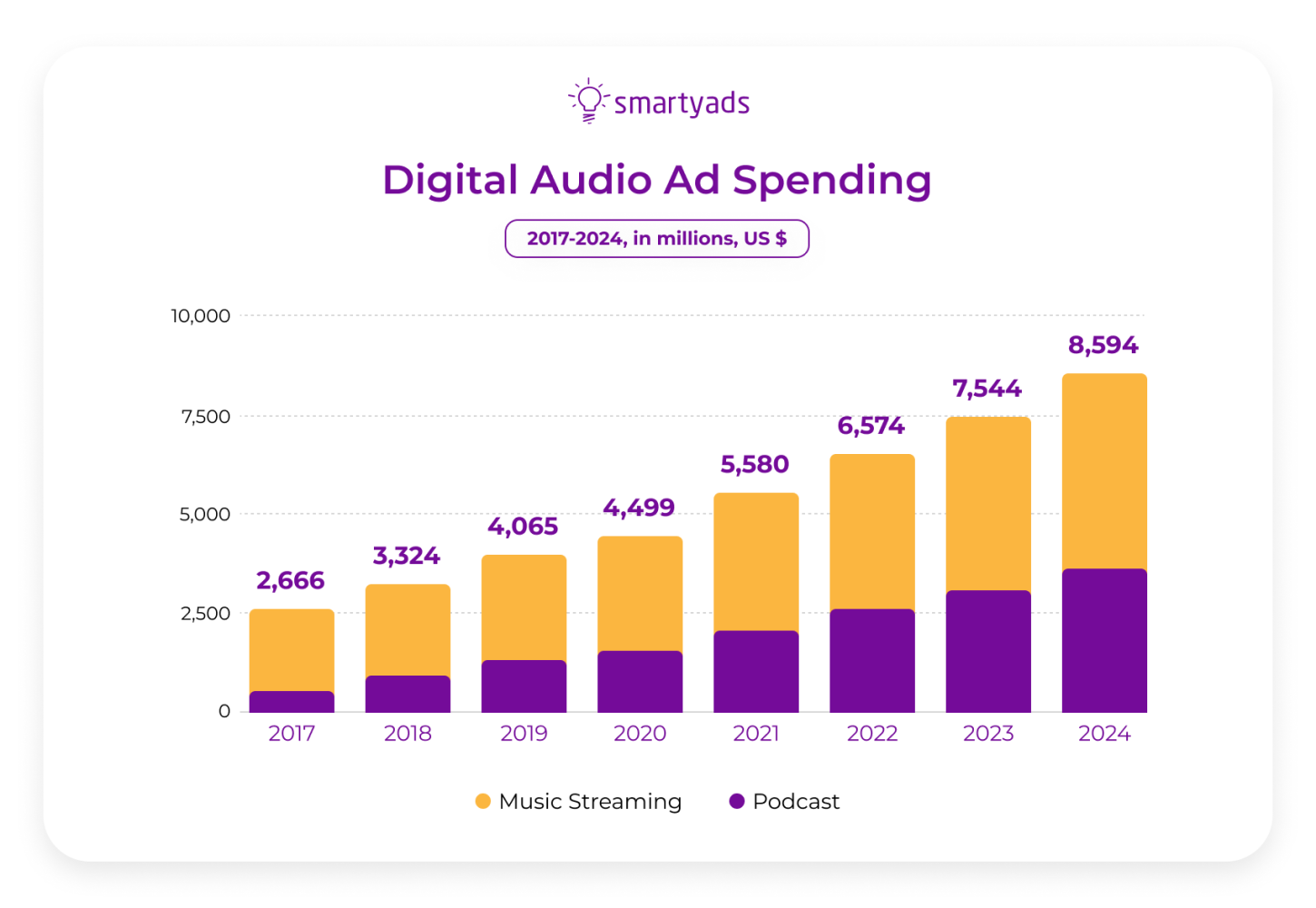
Create compelling creatives and visuals
Your creatives and visuals should be eye-catching and persuasive. This is the face of your campaign; it should grab attention and stick in the user's mind as an association with your brand. They should emphasize the benefits of your offer and create a sense of urgency to drive your audience to action.
Test and optimize your campaign
Collect data at every stage of your direct response campaign, and conduct A/B testing to identify the best marketing strategy. This will allow you to improve your performance and increase your effectiveness. Test different campaign elements like the offer, CTA, and advertising channels to see what works best. Use data and analytics to optimize your campaign and improve results over time.
Remember that direct response marketing is about getting immediate feedback from your target audience. This can be intimidating, but it actually gives you a huge advantage because you can react instantly and adjust your strategic decisions by analyzing the information you receive.
Direct response marketing campaign examples:
1) The New York Times often uses Instagram to promote discounted subscriptions with unlimited access to the material. A short message with a clear CTA immediately explains to the user what they need to do and what benefit they will receive. Because Insta-stories can only exist for 24 hours, this message also feels limited in time, which adds a sense of urgency.
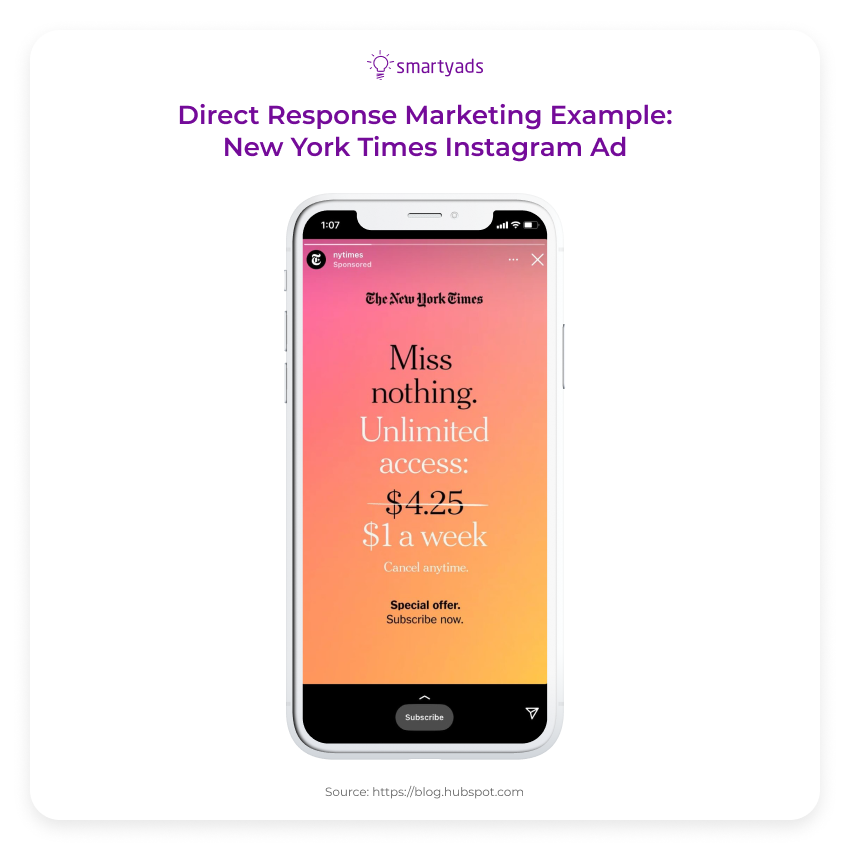
2) Microsoft Dynamics also gives one of those direct-response marketing examples. In this Facebook ad, they are specifically targeting Sales&LinkedIn Sales Navigator interested in closing more deals. They state the problem and immediately offer the solution — a free demo dedicated to showing users the relevance of their product. Here, a call-to-action urges users to schedule a demo which will help them "empower their sales team".
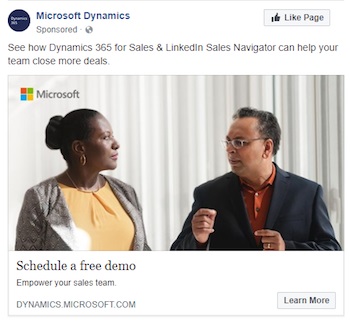
3) Here is another direct response marketing example (by Salesmate). They offer a set of free cold email templates aimed at increasing revenue for consulting agencies. Their prospects are consulting businesses struggling to develop.
The suggested call-to-action includes downloading templates in exchange for an email address. Note how this ad doesn't even try to sell anything, as the primary aim of such a campaign is to build trust and form a mailing list of prospects.
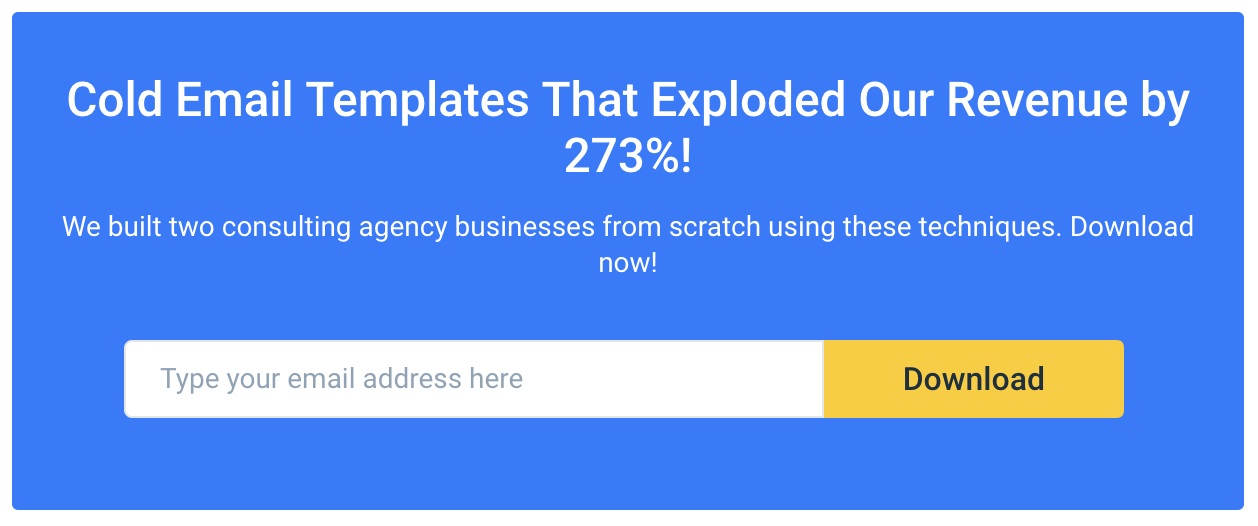
4) Grailed is an online marketplace that allows users to resell various products. They have created automatic email lists that notify users whenever an item they like is reduced in price. It's also a form of direct response marketing.
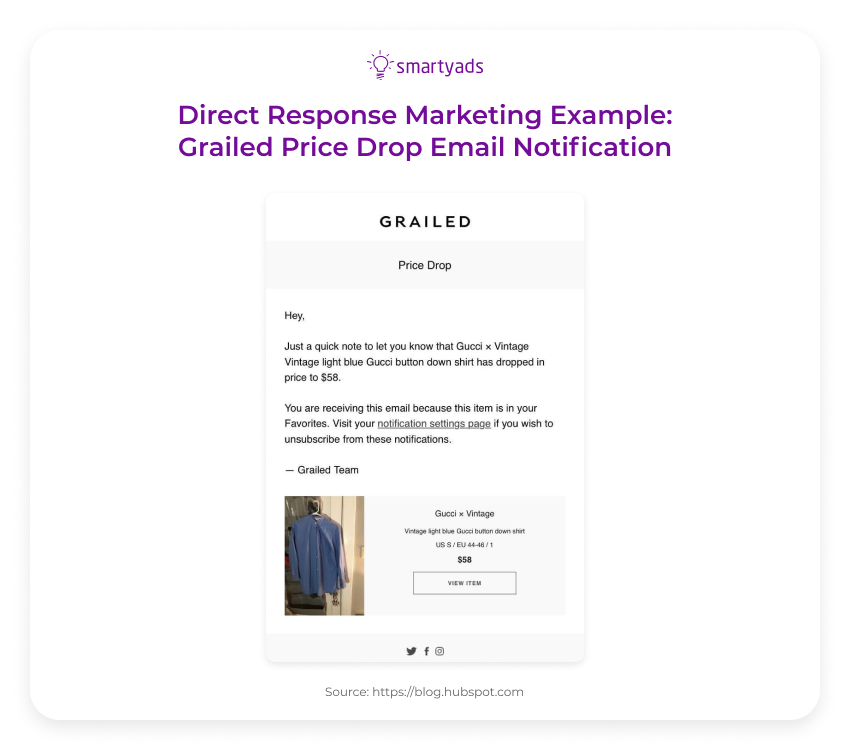
Conclusions
Starting your direct response marketing campaign is now as easy as possible. You just need to state a clear offer, include valuable information about your products or services, and provide means for a direct response via call-to-action.
Once the strategy is complete, you can set up a direct marketing campaign on a demand-side platform and tune it accordingly. Our DSP includes a wide range of targeting and retargeting options so that your messages are delivered to your audience, such as new car buyers, credit card users, clothing shoppers, etc.
